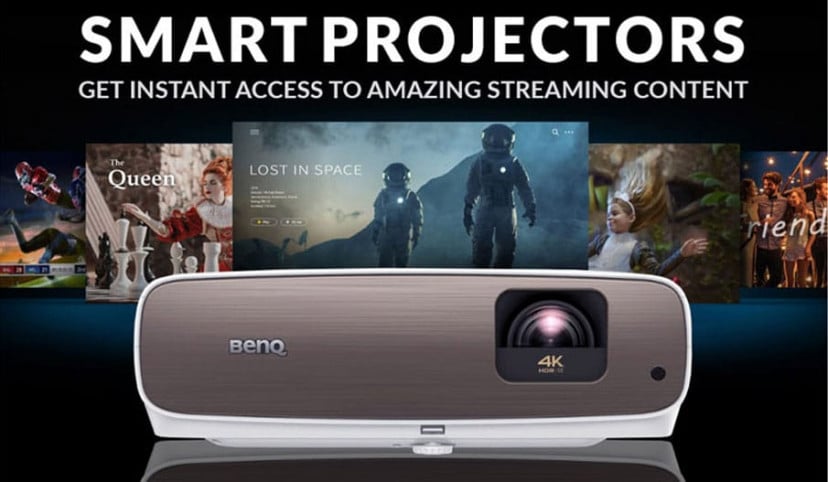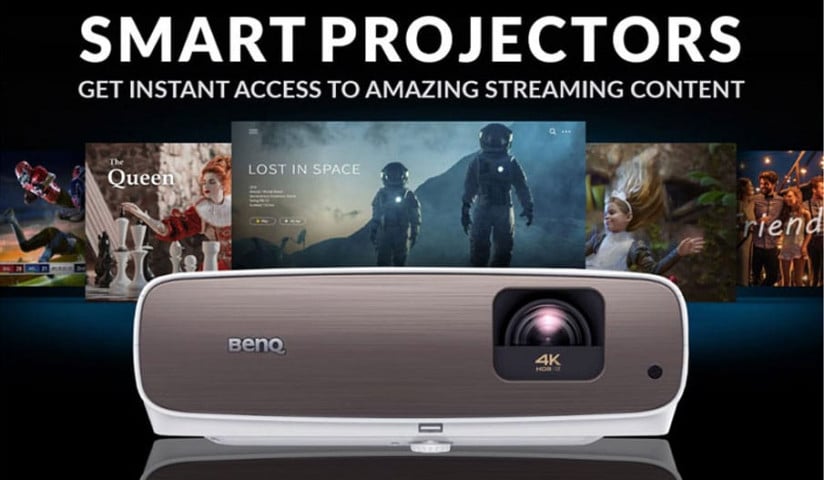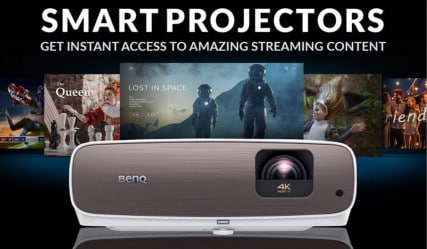For this Blog I am starting off with some additional info related to 3D active shutter glasses then I am beginning (i.e., Part 1) a discussion on things to consider when selecting a screen for use with 3D projectors.
More on 3D Glasses
Another Industry Standard for 3D Active Shutter Glasses
Just after posting the my previous blog on 3D active shutter glasses, there was an announcement that 3D TV manufacturers Sony, Samsung and Panasonic have joined forces with 3D glasses manufacturer Xpand to develop an industry standard for a new generation 3D TVs and for active shutter 3D glasses that will use either radio frequencies (i.e., using Bluetooth
TM) or infrared (IR) for transmitting the required synchronization signal from the 3D TV to the glasses. They call this joint effort the “Full HD Glasses Initiative” with the term “Full HD” perhaps aimed at distinguishing it from half resolution HD LCD flat panel passive 3D systems being promoted by LG and Vizio. The goal of this effort is to have a common solution for the 3D glasses that will work with the 3D TVs from all three of these TV manufactures. While most current 3D TVs and 3D active shutter glasses use IR for delivery of the synchronization signal from the TV to the glasses, it appears the industry will be quickly moving to using Bluetooth over the next year. Glasses build to the industry standard emerging from this activity are expected to be backward compatible with the 2011 models using IR from these 3D TV manufacturers as well as with future 3D TVs from these manufacturers that use Bluetooth. The first 3D TVs and universal 3D glasses based on this new standard are expected to be available in 2012.
Compatibility of Universal 3D Glasses
In a second news item Sony dealers have now begun selling the new entry-level VPL-HW30AES 3D projector bundle (i.e., includes a VPL-HW30ES projector, two pairs of active shutter glasses and an 3D IR emitter). This 3D projector bundle carries a MSRP of $3999 while the projector itself will retail for $3699 when it becomes available (expected to be in September). Art is planning to do a full review of this new Sony model that will appear here on Projector Reviews. Sony has also introduced a new generation of 3D active shutter glasses with this new projector that are said to also be compatible with the Sony flagship
VPL-VW90ES 3D projector. One new owner of a VPL-HW30ES projector has reported also testing it with
“Xpand X103” and with
“MonsterVision Max 3D” universal 3D active shutter glasses. He has reported that the Xpand X103 glasses are not able to maintain synchronization
* with the projector for more than a few seconds at a time, and the MonsterVision Max 3D glasses show substantially higher levels of 3D crosstalk (ghosting) than when viewing 3D video with the new Sony 3D glasses. Thus, based on this one user report, it appears neither of these “universal” 3D active shutter glasses, as they now stand, are compatible/suitable for use with this new Sony 3D projector.
* 8/29/2011 UPDATE - Other users have reported success in using the Xpand X103 glasses.
Screens for 3D Projection – Part 1
This discussion will focus on factors that need to be considered when selecting a projection screen for use in a home theater with a 3D projector. While many of the screen characteristics equally apply to selecting a screen for regular 2D projection, there are some factors that are either more important when it comes to 3D or apply only for the case of 3D. I intend to focus on those screen characteristics that apply to 3D projection and intend this information as a supplement to the information on screen selection that already exists here on the Projector Reviews web site. There are already several articles here on Projector Reviews that discuss types of projection screens and screen characteristics. The top-level summary article is
HERE.
Projection screens are passive devices whose job, in the simplest of terms, is to display the projected video image to the viewers. Screens used in home theaters are available in a number of different physical/mechanical configurations, including motorized drop down screens, manual pull-down screens, fixed frame screens, and even painted-on-the-wall screens. Also some screens employ fabrics that are tensioned while other screens use free hanging non-tensioned fabrics (essentially tensioned only by gravity along the vertical axis). For this blog I don’t intend to get into these mechanical characteristics of the screens. Rather, I will address the characteristics related to the manner in which the projected light is reflected by the screen surface and how these relate to 3D performance. For more information on the physical screen characteristics see the Projector Reviews article
HERE.
There is a good overview
HERE on the terminology used to describe the performance characteristics of projection screens. In the following paragraphs I will discuss these performance characteristics and the significance of each in the context of 3D projection. If you read the reviews here on Projector Reviews for some of the better home theater oriented 3D projectors (e.g.,
Sony VPL-VW90ES or
JVC DLA-RS60 or
LG CF3D) you will find that 3D projection can present some challenges beyond what is associated with traditional 2D projection in a home theater environment. All 3D projection systems will present substantially less light to the viewer’s eyes in 3D mode as compared to 2D viewing (i.e., without the 3D glasses) using these same projectors.
Goals for selecting a Screen with the Right Characteristics
Where selecting a screen I suggest you keep the following goals in mind (this is not intended to be a comprehensive list of goals):
- For a home theater with full control of lighting (think near bat cave dark for movie viewing), the industry standards bodies Society of Motion Picture and Television Engineers (SMPTE) and THX recommend a image brightness (technically called luminance) of 16 foot lamberts and a minimum level of 12 foot lamberts. It is also suggested by SMPTE that for the cinema experience the maximum level not exceed 20 foot lamberts. This is as measured at the viewers location. The above recommendations are for 2D presentations and there are currently no published industry standards for image brightness for 3D (SMPTE is working on such a standard). It is generally accepted for commercial cinemas to permit a lower brightness level for 3D (including the light loss of the 3D glasses). It appears that image brightness levels for 3D as low as 5 to 7 foot lamberts are considered acceptable to many viewers, while higher levels would probably be considered preferable. Most of us that grew up watching very bright CRT TVs (and now very bright LCD flat panel TVs) that frequently have a image brightness of more than 50 foot lamberts. Some home theater owners want and expect to have that same level of brightness in their home theater. However, if you want a cinema experience at home, then such a high image brightness is both unnecessary and undesirable.
- Unless your room’s physical layout restricts the size of the projection screen that can be accommodated, you should have as a goal to select a screen that is large enough to give you a true cinema experience (more on this below in the discussion of screen size).
- Another goal should be to select a screen material that does not introduce objectionable artifacts, such as “hot spots” , “grain”, or “sparklies” in the image.
Screen Characteristics
Screen Gain - Gain is the industry term used to measure the amount of light reflecting from a screen surface. No actual overall light “gain” takes place. Gain measures the screen brightness and directional characteristics. A Matte White screen surface is usually 1.0 gain, or unity gain, and this is generally the ‘reference’ for projection screens.

Reference Gain=1.0 Screen
A gain of greater than 1.0 is achieve by the screen surface focusing the reflected light into a cone. The narrower the cone then the more concentrated the reflected light will be and the greater the gain value associated with the screen.

Screen with Gain > 1.0A projection screen’s peak brightness occurs when the viewer is perpendicular to the center of the screen (assuming the projector is also centered left-to-right with the screen). As the viewer moves out to the side, away from the center-line of the screen, the brightness of the image will drop. When the brightness drop off reaches 50% of the peak brightness, that determines the screen’s half gain point (or half brightness). How wide or narrow this cone is will normally be expressed by the screen manufacturer as the Half Gain Angle. For example, if a screen were rated with a gain of 2.0 and a half gain angle of 30 degrees, that screen would have a gain of only 1.0 when viewed from a position 30 degrees to the right or left of the screen’s center-line position. In this example, as a viewer moves more than 30 degrees off the screen center-line they will experience increasingly dimmer images as the screen gain continues to fall off. Thus, using a screen with a gain of greater than 1.0 will produce brighter images, as compared to a reference unity gain screen, for viewers seated near the screen center-line, but with the penalty of having more restricted seating locations for the viewers.
3D projection systems can have substantially lower effective lumens output in 3D mode (e.g., up to 85% less effective lumens when both the projector and the 3D glasses are considered, as discussed in my previous blogs). The use of a projection screen with higher gain is one technique to help overcome the lower lumens typical in 3D mode. When considering a higher gain screen, home theater owners need to determine their maximum viewing angle requirement. If your home theater has one or more rows of seats, then the angle from the front row end seat to the center of the screen will typically have your maximum viewing angle. The following is provided as an aid to determining your maximum viewing angle.
Viewing Angle Illustration1. Measure the distance from the center of the screen perpendicular back to the center of front row of seats and record this in inches (or cm). We will call this value
D
2. Measure the distance from the front row center seat (as used in number 1 above) to the middle of the most distant end seat in the front row and record this in inches (or cm). We will call this value
S
3. Next calculate the ratio between these two distances by dividing the center to side seating distance by the screen to center seat distance as per this very simple formula:
Distance Ratio = S/D
4. Once you have calculated this distance ratio read the associated viewing angle off of the graph below. For example if the Distance Ratio = 0.4 then the viewing angle equals approximately 22 degrees.

Viewing Angle vs. Distance Ratio Graph
Once you know your maximum viewing angle you will generally want to select a screen for which the manufacturer’s specified Half Gain Angle is greater than your actual maximum viewing angle. This will ensure that even viewers in these end seats will have an image brightness that is more than 50% of the peak brightness as seen from the center seat.
Screen Size - Some people planning their first home theater tend to think bigger is always better when in comes to screen size. However, when it comes to selecting a screen size, sometimes smaller is actually better. There are two factors to consider when selecting a screen size. The first is for a given projector, and for the given projector’s light output, using a larger screen results in a dimmer image. Given that the effective image brightness with 3D projection system is already significantly lower than for 2D, achieving adequate image brightness becomes even more of a challenge. The second factor that impacts the maximum appropriate screen size is the viewing distance. The motion picture industry has established standards for screen size vs. viewing distance based on the projected image filling what they consider to be the optimum field of view. One organization with such standards is the Society of Motion Picture and Television Engineers (
SMPTE) and another is THX. These standards express recommended viewing angles (i.e., field of view) for the projected images. SMPTE recommends a nominal viewing angle of 30 degrees while THX recommendations allow for viewing angles of up to 40 degrees. These viewing angle recommendations are as measured from the viewer’s eyes to the right and left edges of the projected image. Thus for a given viewing distance, as the screen width is increased the image will fill a greater field of view with a larger viewing angle. I have prepared the chart below as guidance to the maximum screen size based primarily on the THX recommendations. This does assume that the projected image has adequate resolution and freedom from visible pixel structure, which should be the case when using a 1080p resolution projector. The following chart shows the recommended maximum diagonal screen size for both a HDTV 16 x 9 (i.e., 1.78:1 aspect ratio) screen and for a ‘scope’ (2.40:1 aspect ratio) screen. Just remember this chart is only a recommendation for
maximum screen size and smaller screen sizes may be more appropriate for your specific situation. Also some people feel that a somewhat larger screen size is still acceptable for a home theater as long as the image brightness is adequate, but this becomes a matter of personal preference.
___________________________________________________________
--------- TO BE CONTINUED -----
___________________________________________________________
My next blog with continue the discussion of Screens for 3D Projection.




